March/April 2024
Buzz pollination
In the sprawling orchards of almond groves and amidst the blossoming cherry and apple trees, pollination is not just a natural process, but a carefully orchestrated part of successful crop production.
Koppert Biological Systems, an agricultural crop protection and natural pollination supplier, utilizes natural enemies to combat pests, bumblebees for pollination and microbials and biostimulants to support, protect and strengthen crops. Its focus is on sustainable approaches to help growers overcome challenges.
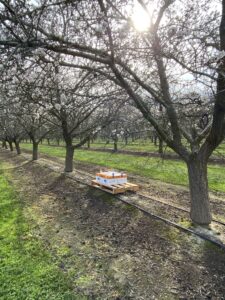
In recent years, Koppert has worked with almond growers along the West Coast, offering specialized pollination services tailored to the unique needs of each orchard. I recently met with Olivia Lake, technical sales consultant specializing in outdoor agriculture pollination and IPM for Koppert. She graduated from Purdue University with a degree in agronomy and after working in horticulture as a greenhouse grower, decided to join Koppert’s team.
She shared some insights into Koppert’s services and also what she enjoys about her role.
Tell us about Koppert and your history?
Olivia Lake (OL): At Koppert we believe the answers to sustainable agriculture lie within nature itself. We partner with nature to help our planet find its balance — using natural enemies to combat pests, bumblebees for pollination, microbials and biostimulants that support, protect and strengthen crops.
We were founded in 1967 by Jan Koppert, a Dutch grower with a clear vision; the world needed an alternative for chemical pesticides.
A clear goal we can’t complete on our own. That’s why we team up with growers, partners, universities, research stations and governmental bodies worldwide. Together we contribute to the better health of people and the planet.
What pollination services do you provide?
OL: We work with many crops from cucurbits, berries and vegetables to orchard crops such as almond, cherry and apple. In almonds, we have launched an outdoor native yellow faced bumblebee pollination service.
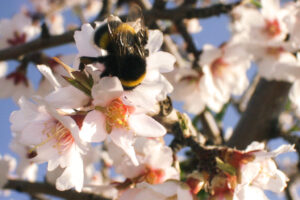
One of the hallmarks of Koppert’s approach is its timing and communication with growers. Koppert delivers its hives with precision, ensuring that bees are introduced in almond orchards at the optimal bloom stage, typically around 5%.
This bumbler is an efficient and effective pollinator in western crops, especially almonds. As part of the pollination service, as a consultant I will walk the crops together with the grower, checking hive activity, answering questions and giving recommendations to the growers.
Tell us about the pollinators used for your services and how they differ from honeybees.
OL: We use two pollinators — the common eastern bumblebees and yellow faced bumblebees. Both are native to their regions, whereas honeybees are native to Europe.
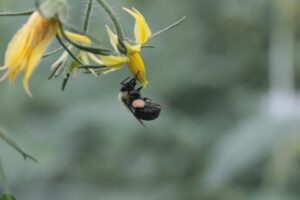
Bumblebees are recognized as very efficient and reliable pollinators. Bumblebees maximize a grower’s assurance, due to their ability to buzz pollinate for efficient transfer of large amounts of pollen. They forage at low temperatures (as low as 40o F) and on cloudy and windy days (they can withstand winds up to 40 mph). They provide an integrated approach to pollinating, enhancing the work of honeybees and forming a healthy competition.
Bumblebees and honeybees are both fantastic pollinators; they just work differently. Bumblebees fill in the spaces where honeybees are not active, such as in low temperatures, cloudy, foggy and rainy days.
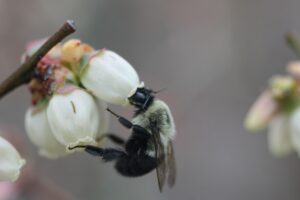
Bumbles pollinate through a method called “buzz pollination” where they produce a rapid vibrating motion to release large amounts of pollen onto the bee or directly on the stigma. Buzz pollination allows a bumblebee to pollinate a flower in a single visit — increasing the quality of pollination.
Can you provide more information on how the hive works and how/if automation plays a role?
OL: Bumblebee colonies are ruled by a queen, the colony’s mother. Each hive has its own queen and workers. The hives are built by the queen and her workers before they arrive on the farm.
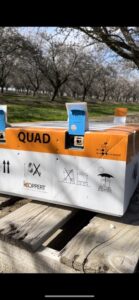
After the hives are introduced to the farm, the worker bumblebees start pollinating the flowers while simultaneously collecting pollen to feed the brood. More workers emerge from the brood in the weeks after introduction, increasing both colony size and pollination performance. After some weeks the colony will reach its maximum size and starts declining in size and pollination activity.
Bumblebees only live one season, with the new queen hibernating during the cold winter months. Before hibernation, she will mate with a drone bee and find a cozy and safe spot for the winter.
Automation plays a small role in the production of our bumblebees. Rearing them is a process of selecting and creating the ideal environment for them to thrive. When it comes to rearing live insects, it’s a hands-on approach. We do have a feature with automated doors designed for the greenhouse that allows growers to open doors in a large greenhouse based on a timed schedule.
Can your bees work well alongside native honeybees to improve pollination of crops?
OL: It is easy to add bumblebees into a pollination plan. We set up a meeting with the grower to learn about their pollination needs and about their crops. Once we determine how many bumblebee hives they would need, we place an order well ahead of pollination season.
The hives arrive via truck or UPS, the grower will set them out in the fields, open the hive doors and let the bees do their thing!
Bumblebees work well with honeybees, creating a competitive pollination program. Use both bees with caution, however, as honeybees will raid bumblebee hives if there is not an adequate food source. Honeybees tend to be more aggressive, so we highly recommend keeping honeybees and bumblebee hives at least 800 feet apart from each other.
The differences between honeybees and bumblebees
- Temperatures: Bumblebees active at 40o F; 60o F to 65o F for honeybees.
- Time of a day of pollination: Bumblebees leave hives early in the morning, honeybees leave hives later.
- Light levels: Light is a big factor for bees and it is
a trigger for them to work. In lower light levels, bumblebees will come out and even venture out in foggy, misty and light drizzle. Honeybees prefer high light levels and will not come out in foggy, misty or light rain. - Wind: Bumblebees will fly in quite windy days — up to 40 mph winds. Honeybees will fly in winds up to about 15-20 mph.
- Communication: Bumblebees don’t have the same sophistication level in communication as honeybees. Honeybees are hard workers and fan out from hives, they’ll fly farther, whereas bumblebees will stay closer — up to a mile from the hive.







